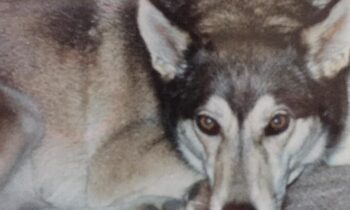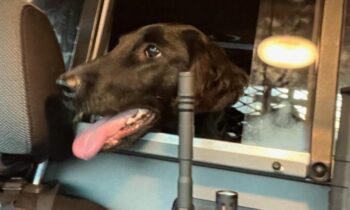

You’ve got a puppy or a young dog. You’re raising that young animal to be a well-behaved pet, a good companion, an excellent family member. You hope your new canine housemate will have a long and happy life. You plan to do all you can now to ensure that your new family member will be prepared for anything that long life may throw at him or her. You know it won’t be easy. You’re sure it will be worth it!
Two weeks ago, we talked about preparing your young pet dog for the physical assists you may need to give her as she ages—lifting, carrying, boosting, and steadying—and why practicing those skills now is so important for both of you. Last week, we discussed footwear and why your dog might need it later, even if he doesn’t now.
You’re starting to get it: you’re preparing your pup to live the best life he or she can live. Thinking ahead to illness, infirmity, and old age makes great sense.
This week, we’ll cover a number of doggy items your pet may need in the future, so you can introduce him or her now to wearing those items well. Remember, it’s not your job to stress or intimidate your dog with the forced wearing of anything that bothers or alarms him. Instead, it’s your job to show her, gently and with great care, that all of these items are—first and foremost—safe.
For a dog, safe means “it doesn’t hurt, frighten, or bother me.” It might also mean, “I find it rewarding to have this item near or on me.” In addition, over the long run, safe might come to mean, “Hey, I like that item. It’s always been rewarding to have it near or on me, and I don’t mind it at all.”
To a dog, it’s important that new things are introduced slowly, so the dog has lots of time to get used to, first, seeing the new thing, preferably from a distance. The dog can then choose to approach more closely, eventually sniffing, touching, even pawing or licking to get tactile feedback.
This part is easy.
▪ Put the item in a familiar and safe space where the dog can choose to interact or not. The more room, the better.
▪ Don’t hover over the dog. Stand back where you can watch.
▪ Don’t force the interaction! Let the dog decide whether approaching the item is a good idea. You have all the time in the world.
▪ Put the item on the floor and leave it there. Wait for the dog to decide what to do next.
▪ Be patient. It could take a while. But be prepared—it could happen instantly.
One dog might see that item out of the corner of her eye and decide to leave the area immediately. That’s fine, let her leave.
From you and any other humans present, there should be no sound, no body language and, if possible, no emotion felt that indicates disappointment in the dog’s behavior.
Observe, don’t react.
Another dog might spot that item upon entering the room and leap upon it in excited interest! That’s fine, too.
Have a back-up plan if the dog indicates he’s going to destroy the item immediately. I’d suggest the yummiest food rewards you’ve got, given to the dog while a helper spirits the item away (if the dog is food-oriented), or use her favorite toy. Then reconsider your introduction plan. Maybe the item should be introduced from the inside of an exercise pen or other side of a baby gate, so the dog can see it—even choose to touch it—without being able to grab it and destroy it.
Should you discover your pup or young dog seems truly committed to destroying every item you introduce, I strongly urge you to seek the advice of your puppy class or pet dog class instructor. If your dog has not yet attended a class, contact an ethical and reputable force-free dog trainer to evaluate the dog and his behavior before you continue the introduction of new items on your own.
I advise exactly the same—contact an ethical and reputable professional—if your dog seems to be frightened or fearful of all or most new items you introduce to her. Do not proceed without help!

Photo by Jill Gibbs — Henry, three months old
What sort of items should you introduce first?
I suggest one item that most pet dogs will encounter within their first few years. Often called “the cone of shame,” it’s formally known as the Elizabethan collar, for its (questionable) resemblance to the high, stiff, uncomfortable fashion popular in the court of Elizabeth I, England’s monarch in the second half of the 1500s.
Luckily for your dog, and for you as an owner, the plastic “cone” that fits around your dog’s head to prevent her mouth from reaching healing areas of her body after veterinary care is quickly going out of fashion, replaced by alternatives far more suitable to a variety of dogs and sizes.
Ask your veterinarian what sort of device will be required for your dog. Ask when you bring your dog into the clinic for the first time, for the well-pet exam that’s offered for your newly adopted animal. If your puppy or dog will eventually be neutered, ask as long before that procedure as possible.
Your veterinarian will consider your dog’s size and shape, plus any special factors in your situation. See what that particular clinic recommends. Also ask what it has for client animals to use during their recovery, sometimes at no extra charge, as well as what they sell. You might even see an animal or two, other clinic patients, wearing those items.
Once you know which Elizabethan-collar alternative your veterinarian recommends and why, borrow one to take home to introduce to your dog. If your dog is still growing, borrow one that fits him now.
If your dog is fully grown, buying your first choice of “E collar” from a locally owned pet supply store with a good return policy is ideal. You’ll be able to exchange for a different size or style or return it for a store credit. Buying online, sight unseen, may be more iffy, but many pet-supply sites do accept returns of items that don’t suit the pet they’re bought for, or issue credit for another purchase.
When you have the item to introduce to your dog, choose that safe space where you’ll put it down for the dog to investigate, and get started. Every dog’s reaction will be different. Take as much time as you need—as your dog needs—but only in short sessions every day. The younger the dog, the shorter the session. With a puppy, it could be a matter of seconds. With an older dog, maybe a few minutes at most.
Your job is to allow the dog the time he needs to be totally comfortable with approaching and being near the item, eventually investigating it in whatever way (short of destruction) the dog chooses.
Then sit on the floor with the dog and pick up the item, move it a little, give your dog another opportunity to choose to interact . . . and so on.
The dog will come to accept the item’s movement, the item’s touching the dog, the item set “on top of” the dog, “around” the dog, etc. Until finally, you’re able to fasten the item onto the dog and take it off (yes, on and off comes first). Then the item stays on the dog for a second, then two seconds . . . you can see where I’m going.
Ideally, long before your dog “wears” whatever version of the E collar you’ve chosen, your dog will understand that the item is safe. He’ll understand because nothing he’s ever experienced of the item has frightened, threatened, or hurt him. To the dog’s mind, the item has behaved safely. That’s on you!

Photo by Jill Gibbs — Henry, nine years old
Imagine that your dog is going to be neutered. She will need to wear some version of an E collar to protect the healing area after the surgery. She has been introduced to the appropriate E collar alternative over time in a force-free manner, and she has come to see wearing it as a rewarding experience with a safe item.
You’ll always worry when your dog has surgery, but at least you won’t have to worry about how she’ll react to one aspect of recovery. That protective “collar” is an old friend!
What other wearable items should you introduce to your young dog?
▪ Eye protection—goggles and shades
▪ Ear protection—from sound or cold
▪ “Pants”—for female dogs in season
▪ Belly bands—for male dogs who urinate inappropriately
▪ Diapers—for dogs with incontinence issues
Again, consider what experiences and activities you’ll be pursuing with your dog as she grows up. Will she be riding in your convertible with the top down, in a sidecar on your motorcycle, aboard your speedboat on the lake? Will he be subjected to loud noises like concerts, fireworks, explosions? Will she come into season, will he “mark” in the house? Is there a chance of incontinence?
Don’t rule out too many possibilities. Things change, stuff happens. Prepare now for whatever may come in your dog’s maturity and old age.
Alternatives To The Cone Of Shame:
https://www.petmd.com/dog/care/alternatives-cone-shame
Next week: Introducing your puppy or young dog to skills needed for veterinary care, including using a crate or exercise pen for confinement during recovery, eliminating while on leash or long line, veterinary exams, shots, taking meds by mouth, wearing a muzzle in a veterinary setting, and the ever-popular getting a urine sample!



